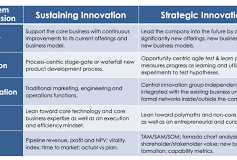Exploring Sustaining Innovation Examples for Long-Term Success

Sustaining Innovation Examples: Driving Growth and Success
Innovation is the lifeblood of progress and success for any organisation. While disruptive innovation often grabs headlines, sustaining innovation plays a crucial role in driving long-term growth and maintaining competitive advantage. Sustaining innovation involves incremental improvements to existing products, services, or processes to enhance efficiency, quality, or customer satisfaction.
Examples of Sustaining Innovation:
-
Apple’s iPhone Iterations:
Apple is known for its sustained innovation in the smartphone industry. With each new iPhone release, Apple introduces incremental upgrades such as improved camera technology, faster processors, and enhanced user experience while maintaining the core design principles that customers love.
-
Toyota’s Lean Manufacturing:
Toyota revolutionised the automotive industry with its sustained innovation in lean manufacturing principles. By continuously refining production processes to eliminate waste and improve efficiency, Toyota has set a benchmark for quality and cost-effectiveness in the industry.
-
Google’s Search Algorithm Updates:
Google constantly refines its search algorithms through sustaining innovation to deliver more relevant and accurate search results to users. These incremental improvements help Google maintain its position as the leading search engine globally.
-
Nike’s Product Line Extensions:
Nike regularly introduces new variations of its existing product lines through sustaining innovation. By offering updated designs, materials, and technologies in footwear and apparel, Nike keeps customers engaged and loyal to the brand.
Sustaining innovation is not about reinventing the wheel but about making continuous enhancements that add value to existing offerings. By focusing on sustaining innovation alongside disruptive breakthroughs, organisations can build a sustainable foundation for growth, profitability, and relevance in a rapidly evolving market landscape.
Embracing a culture of ongoing improvement and customer-centricity is key to successfully implementing sustaining innovation strategies that drive long-term success.
Exploring Sustaining Innovation: Examples and Insights from Real-World Applications
- What are examples of sustaining technology?
- What is an example of sustaining or incremental innovation?
- What are the 4 types of innovation with examples?
- What are real world examples of sustaining innovation?
- Is Uber a sustaining innovation?
What are examples of sustaining technology?
Sustaining technology refers to incremental improvements made to existing products, services, or processes to enhance their performance, quality, or efficiency over time. Examples of sustaining technology can be seen in the continuous updates and upgrades made to smartphones, such as improved camera features, faster processors, and enhanced user interfaces. Another example is the evolution of online search engines, where algorithms are constantly refined to provide more accurate and relevant search results. In the automotive industry, sustaining technology is evident in the development of more fuel-efficient engines and advanced safety features in vehicles. These examples demonstrate how sustaining technology plays a vital role in driving ongoing progress and innovation within various sectors.
What is an example of sustaining or incremental innovation?
An example of sustaining or incremental innovation can be seen in the continuous updates and improvements made to popular smartphone models, such as the iPhone by Apple. With each new iteration, Apple introduces incremental enhancements to features like camera quality, processing speed, and user interface design while maintaining the fundamental design elements that users appreciate. This approach to sustaining innovation ensures that the product remains competitive in the market by meeting evolving customer expectations and technological advancements without drastically altering its core identity.
What are the 4 types of innovation with examples?
Innovation encompasses various forms that drive progress and success in organisations. The four types of innovation include product innovation, process innovation, business model innovation, and marketing innovation. Product innovation involves creating new or improved products to meet customer needs, such as Apple’s introduction of the iPhone. Process innovation focuses on enhancing operational efficiency and effectiveness, like Toyota’s implementation of lean manufacturing principles. Business model innovation entails redefining how a company creates, delivers, and captures value, exemplified by Airbnb’s disruptive sharing economy model. Marketing innovation involves developing novel strategies to promote products or services, such as Coca-Cola’s iconic advertising campaigns. Each type of innovation plays a vital role in shaping industries and fostering growth and competitiveness in the ever-evolving business landscape.
What are real world examples of sustaining innovation?
Real-world examples of sustaining innovation abound across various industries, showcasing how organisations continually enhance their products, services, or processes to meet evolving customer needs and stay competitive. From Apple’s iterative upgrades to the iPhone that improve user experience while retaining brand loyalty, to Toyota’s commitment to lean manufacturing principles for efficiency and quality in automotive production, and Google’s ongoing refinement of search algorithms for better search results accuracy, these examples demonstrate the power of sustaining innovation in driving long-term success and growth. Such sustained efforts not only maintain market relevance but also foster customer satisfaction and loyalty in a dynamic business landscape.
Is Uber a sustaining innovation?
Uber can be considered a sustaining innovation in the transportation industry. While Uber revolutionised the way people hail and pay for rides, it did not fundamentally change the concept of transportation itself. Instead, Uber improved upon existing taxi services by leveraging technology to provide a more convenient and efficient ride-sharing experience. By offering features such as real-time tracking, cashless payments, and driver ratings, Uber introduced incremental improvements to the traditional taxi model. This sustained innovation has reshaped the way people commute but has not disrupted the core concept of point-to-point transportation.
